The topic of the text is "How Neutron Stars are Created" and it explains the process of how these stars are formed in the universe.
Neutron stars are extremely dense and small celestial bodies that form after a supernova. They are composed almost entirely of neutrons and have a mass greater than that of the sun. Manhattan-sized but with a mass twice that of our sun.
So dense. A teaspoon of their matter weighs a billion tons. Mind-blowing objects that arrive with a bang. Neutron stars spark into life amid the death of their parent star. They are the ultimate story of resurrection or of life from death. It's all part of a cosmic cycle.
Stars are born from giant clouds of very cold gas.
Those clouds collapse under their own gravity and the density of the core at the center of that collapse starts to increase. A star is a huge nuclear fusion reactor. The force of its gravity is so powerful that it fuses atoms together to make progressively heavier and heavier elements. The star fuses hydrogen into helium once it exhausts its hydrogen. Then, if it's massive enough, it can start fusing helium at its core. Fusion continues forming carbon, oxygen, and nitrogen all the way up to iron. Once the star has iron in the core, it's almost like you've poisoned it, because this extinguishes the nuclear reactions in the core of the star. You fuse something into iron and you get no energy. All of a sudden, there's nothing to support.
The crush of gravity. No radiation pressure. Pushing out means no pressure keeping the outer regions from falling in. And that's what they do. As the star collapses in its death throes, its core becomes the wildest, craziest, and freakiest pressure cooker in the whole universe. The ingredients are all in place. Time to start cooking up a neutron star. If we were to scale up an atomic nucleus to be the size of a baseball in a normal atom, the nearest electron would be way over in those trees. But in the extreme conditions that lead to the formation of a neutron star, those electrons can be pushed closer to the nucleus. They can come zipping in from any direction, and if the temperatures and pressures are high enough, they can even strike the nucleus and enter it and they can hit a proton. And when they do, they become converted into more neutrons.
So in the formation of one of these objects, the protons and electrons disappear and you're left with almost entirely pure neutrons, with nothing to stop them from cramming together and filling up this entire baseball with neutrons, leading to incredibly high densities. With the sea of electrons now absorbed into the atomic nuclei, the matter in the stars can now press together a lot tighter. It's like squeezing 300 million tons of mass into a single sugar cube. As the star collapses, enormous amounts of gas fall towards the core.
The core is small in size, but huge in mass. Billions of tons of gas bounce off of it, then erupt into the biggest fireworks display in the cosmos. A supernova. It's massive, it's bright, it's imposing. Supernova are among the most dramatic events to happen in the universe. The single star dying, one star dying can outshine an entire galaxy. And arising out of this cataclysm, a new and very strange cosmic entity. When the smoke finally clears from the supernova explosion, you're left with one of the most real, fascinating, unbelievable monsters in the entire universe. Humans have been witnessing supernovas for thousands of years, but we're only now just starting to understand what we've truly been witnessing. The births of neutron stars.
But while supernovas are big and bright, neutron stars are small, and many don't even give off light. So how many neutron stars are out there? We know of about 2000 neutron stars in our galaxy, but there probably are many, many more. I'm talking about tens of millions in the Milky Way alone, and certainly billions throughout the universe. Neutron stars may be small, but some give themselves away by shooting beams across the universe. Unmistakable pulsing strobes of a cosmic lighthouse.
Our knowledge of neutron stars is expanding fast. But we didn't even know they existed until a lucky discovery just over 50 years ago. Cambridge, the Mullard Radio Observatory. Jocelyn Bell. Grad student operating the new radio telescope, scanning the sky, doing all sorts of cool astronomy stuff, and seeing what she calls a bit of scruff in the data. This scruff is a short but constantly repeating burst of radiation originating from a thousand light-years from Earth. It's so stable and regular that Bell is convinced there's something wrong with her telescope. She returns to that spot and finds a repeating regular signal, a single point in the sky that is flashing at us, continually saying, hai, hai hai, blip. Blip, blip. Boom boom boom. Pulse pulse pulse. Nothing that we know of in the universe has such a steady, perfectly spaced time pulse. It seems so perfect that it must have been artificial. It looks like someone is making that. But it turns out it's not a person, but a thing. What she discovered is called a pulsar. A pulsar is a type of rapidly spinning neutron star.
Neutron stars had been theorized in the 1930s but were thought to be too faint to be detected. Neutron stars were hypothesized to exist, but not really taken seriously. It was just a Oh, that's cute. Maybe they're out there, but probably not. The signal Bell detected seemed like something from science fiction. No one had ever seen this in astronomy before, and some people even speculated that it was an alien signal.
She even called them LGM objects little green men. But then Bell found a second signal. Little Green Men went back to being fiction and pulsars became science fact. The discovery of pulsars came out of the blue. Nobody was expecting this. So it was an amazing breakthrough, really important. Pulsars pulse because they're born to spin.
They burst into life as their parents' star collapses during a supernova. Any object at all that is undergoing any sort of compression event. If it has any initial angular momentum at all, it will eventually end up spinning. As the star shrinks, it spins faster and faster. They spin so quickly because the earth-sized core of a massive star collapses into something as small as a city. So because the size of the object became so much smaller, the rate of spin had to increase by a tremendous amount.



